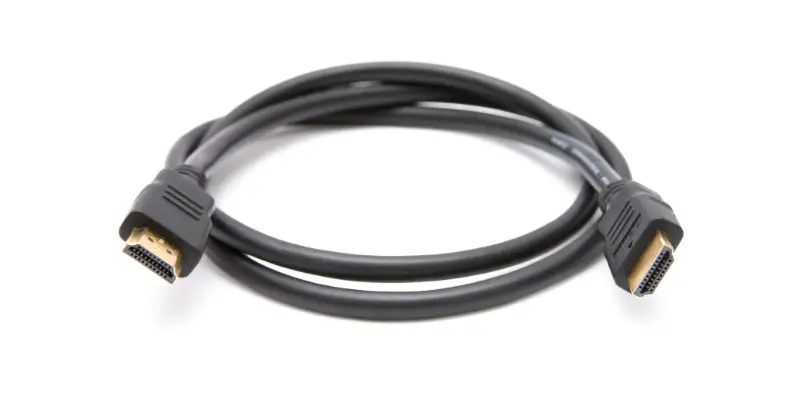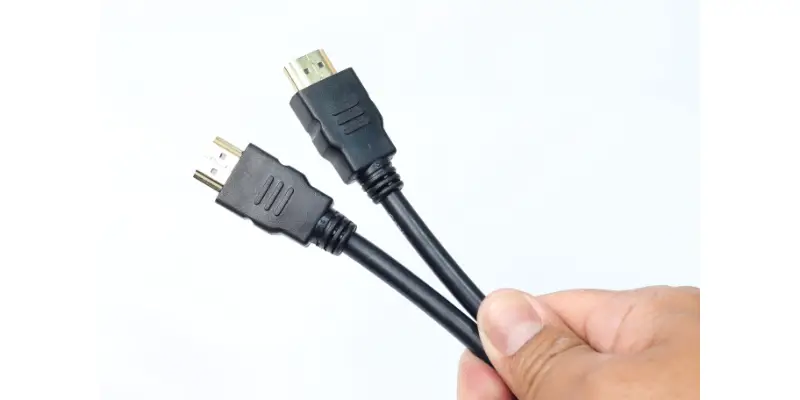Disclaimer: This post may contain affiliate links, meaning we get a small commission if you make a purchase through our links, at no cost to you. For more information, please visit our Disclaimer Page.
As technology has advanced, so have our entertainment needs. The days of just sitting down to watch a movie with family and friends are long gone. Nowadays, we’re streaming all the latest TV shows and films on Netflix and Amazon Prime. We’re also gaming online rather than playing on a console or at the arcade. All this means that finding an HDMI cable that will last is more important than ever before.
A standard HDMI cable can last more than a decade. Many factors can shorten an HDMI cable’s life; however, when someone gives the cable a proper use and care, this can last for over a decade, or some years more than what is shown on the details of the product box.
Table of Contents
Do HDMI Cables Degrade Over Time?
HDMI stands for High-Definition Multimedia Interface, and this is an interface to transmit uncompressed video data, and compressed or uncompressed digital audio data. So, an HDMI cable is responsible for sending High-Definition video and audio data. These cables are very useful since they replace VGA connectors, DVI cables, RCA cables, audio Jack connectors, and every connector that provides just audio or video in separate cables.
HDMI cables replace a lot of connectors to transmit high definition audio and video in just one cable. Thus, HDMI cables come in different shapes and types, so people can connect HDMI cables to different devices. Also, since they are made to transmit HD Multimedia, these cables will provide an image with better resolution. These days, they are even Premium HDMI cables that provide 4K images, and include features such as HDR and expanded color spaces.
An HDMI cable can last for many years; though, there are a lot of elements and situations that can cause a significant degradation on them over time. Quality HDMI cables are made to last; these are made with long-lasting materials that can endure many situations. Despite this, people continue to misuse them, and as a result, cables have a short life.
Now, if we talk about cheap HDMI cables, it has to be seen from another perspective. Cheap cables will have a shorter life since they are poorly constructed, and their soldering points are weaker. Also, they are made of cheaper materials that reduces their overall performance. In the beginning, cheap HDMI cables may perform well but with time, these may suddenly stop working or present flaws.
Also, Electrical cables are mostly made of copper, and HDMI cables are not the exception. Copper is the preferred metal to use in because of their conductivity, and also because they are resistant to heat. In this way, standard HDMI cables are made of oxygen-free high purity copper; this allows the cables to last longer, transmit the video and audio data, and also their oxidation over time is minimal.
HDMI cables have several conductors and connectors that are mostly soldered with copper. The cables are covered with PVC plastic that protects them from the insulation and other external elements that can damage the cable.
Why do HDMI cables stop work?
There are many reasons an HDMI cable has stopped working. Sometimes, these cables can be exposed to elements that can damage them. Even when they are made to be resistant, the constant exposure to, for example, sun or heat will definitely damage the cover and the wires inside and as a result, the cable will stop working.
When the output image starts to fail or the sound fades without “any reason”, it is time to check the HDMI cable. Any loose connector, a broken solder joint, a hole in the plastic cover maybe just be some of the reasons why the HDMI cable has stopped working.
As a result of any of the situations named before, a blurred image, intermittent picture, a faded sound, or just no image nor sound at all can happen. Inferior or cheaper cables tend to have more issues than quality ones and they are not made to last.
The first things to check are the connectors in the cables; also, check for the pins where the cables are connected to the device, sometimes not the cable. Also, the cable can output a poor image or sound because it is too long! Longer cables may have a poor connection.
How Many Years Does an HDMI Cable Last?
In terms of the duration of the materials, an HDMI should last even for more than a decade. Though, this is somehow ambiguous to answer; the reality is that accordingly with the conditions that the cable is exposed, so its durability will vary.
Cheap cables are composed of materials that are barely accepted as “standard”; this low quality will shorten their life. But, if it is talked about premium cables, or those that are just considered standard –but not cheap–, they should last more, or at least, it should last what the description on their box said; considering that the cables are maintained properly.
However, technology is constantly improving, and old cables can be replaced easily. While it is not mandatory to change an HDMI cable every time a new version is out, newer cables come with upgrades to improve the overall performance and to provide a better image and sound.
If I go back to 2002 when HDMI was created, the cables have gone through a few changes and versions to what they are now. Though they have changed physically, HDMI cables have improved their overall performance, and now they can output 4K HD images on a screen, come with ethernet wires to give internet connection, and offer an HQ sound.
How Often Should You Replace HDMI Cables?
An HDMI can last more than people think, and there is no need to constantly replace an HDMI cable. An HDMI should be replaced when there is complete damage without any possibility to be repaired, or when a newer device needs another type of HDMI cable.
It was in 2002 when the first HDMI cable was launched to the market, since that moment, HDMI cables have been through a few generations and different versions; however, there is not a big difference between these. The latest version is the HDMI 2.1 and includes a few upgrades to improve the image and sound experience.
This latest version of the HDMI, the 2.1 version, comes with a set of new features that enhance visual and audio performance. Newer models of TVs and screens are made to use HDMI 2.1, and the next generation of game consoles also used this multimedia interface to improve the overall experience.
However, it is not mandatory to get a new HDMI cable. Actually, the connector of the HDMI 2.1 cable is the same as the previous versions, so the device will still be compatible with previous HDMI cables, but the new features won’t be available.
One of the most significant upgrades with HDMI 2.1 is the bandwidth that allows faster data transmission. HDMI 2.1 has roughly triple the rate of HDMI 2.0; this newer version increases its maximum transmission bit rate to 48 Gbps; this allows it to have a 4K image, and even the next generations 5K, 8K, and 10K resolutions.
With other features that come with the HDMI 2.1, this supports dynamic HDR, a better color spectrum support, and an automatic low latency mode (ALLM) that is very useful for gaming.
So far, the new HDMI 2.1 sounds amazing, but it is not a must to replace the old 2.0 if it is not needed. The devices made for HDMI 2.1 can perfectly run by using the previous 2.0 cables, though, won’t be available the features that come with the 2.1 version.
Though, if older versions are being used, some signs will let you know if newer versions are needed. The main thing to care about is the speed; the image output can be affected since newer formats come with higher resolutions. Also, if the screen is blank, the image is blurred, or something similar, but the cable is in good condition, it means that the device is too new for that old HDMI! So, it’s time to change it and get a newer version.
Conclusion
HDMI cables are made to last; however, many situations will shorten their lives. Instead of constantly repairing the cable, get a new one of the newer versions to enjoy all the features that this can offer; but remember, if it is not needed, don’t change the cable!
References:


